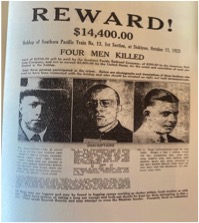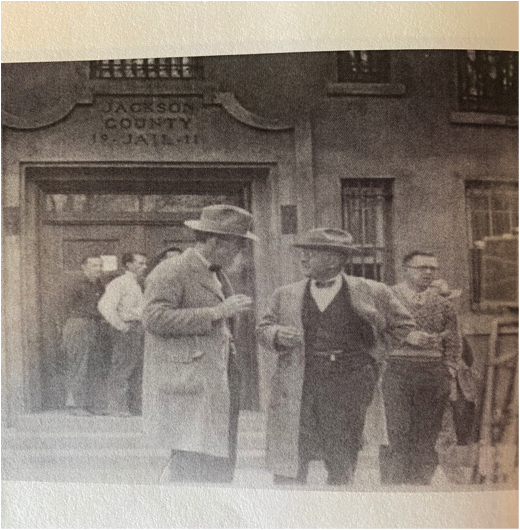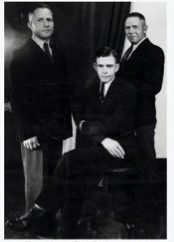|
|
Virtual Walk Through History Stop 2: The Historic Jackson County Courthouse – In 1927, the Jacksonville Courthouse had one last glory moment before the county seat was moved to Medford—the trial of the DeAutremont brothers, Hugh and twins Ray and Roy. Four years earlier, they had staged a train robbery which turned to murder. The press had dubbed it the Siskiyou Massacre and the West’s last great train robbery. It attracted nationwide attention and involved a three-year man hunt extending to Mexico, Canada, and the Philippines. On Thursday, October 11, 1923, as Southern Pacific Train Number 13 emerged from Tunnel No. 13, the three DeAutremont brothers stopped it, believing it carried $40,000 which they planned to make their own. The brothers shot and killed the brakeman, the engineer and the fireman. They dynamited the mail car, but used too much explosive, blowing up the mail clerk and destroying the mail car in the process. The brothers obtained nothing but left behind enough evidence for a scientific analysis to identify the three as the murderers.1
The Southern Pacific Railroad posted a $2,500 reward and the United States Postal Department posted a $5,000 reward; the reward eventually totaled $15,900.2 The Postal Service printed thousands of flyers in at least five different languages and sent them throughout the world. Nonetheless, it took almost four years before the brothers were brought to justice here in Jacksonville.3 In 1924, Hugh DeAutremont had joined the Army under the name James C. Price; Ray and Roy had, over time, made their way to Ohio, where they also lived under different names. Ray even married and fathered a child. Meanwhile, Corporal Thomas Reynolds, who had recently transferred to the army prison on Alcatraz Island, noticed a wanted poster and realized the man shown as Hugh DeAutremont was Private James Price whom he had served with at his last duty station, the Philippines. Hugh was still stationed with his unit in the Philippines and was arrested there on February 15, 1927.4 He admitted to his identity but denied committing murder; he was brought to the Jackson County Jail in Jacksonville to await trial.5 Hugh’s first trial began May 2, 1927, but a mistrial was declared when one of the jurors passed away. A second trial commenced June 10, just two days after Ray and Roy had been apprehended in Ohio.
On June 21, after only 90 minutes of deliberation, the jury returned a guilty verdict against Hugh DeAutremont for the first-degree murder of brakeman Coyle Johnson.6 By this time Ray and Roy had joined Hugh in the county jail, and the twins eventually agreed to plead guilty to the murder of all four victims in order to avoid a death sentence. The brothers were brought before the judge and sentenced to life imprisonment at the Oregon State Penitentiary in Salem.7 In prison, Hugh DeAutremont published Shadows, an award-winning inmate magazine, complete with advertising. He became known as the “Dean of Prison Journalism.” 8 Paroled in 1958, Hugh died of stomach cancer on March 30, 1959. 9
Roy DeAutremont was diagnosed with schizophrenia in 1949, was transferred to the Oregon State Hospital, and underwent a prefrontal lobotomy. He was paroled just before his 82nd birthday in 1982 and died in a nursing home in 1983.10 Ray DeAutremont was paroled on October 27, 1961. When questioned by reporters about how it felt upon finally leaving prison, he replied, “One thing is for sure: For the rest of my life I will struggle with the question of whatever possessed us to do such a thing?”11 Ray moved to Eugene, where he worked as a weekend janitor at the University of Oregon, painted, and studied French and Spanish. In 1972, then-governor Tom McCall commuted Ray’s sentence, and on December 20, 1984, Ray died in a Eugene nursing home at the age of 84.12
1 Webber, Bert. Oregon’s Great Train Holdup: the DeAutremont Case No. 57893-D. Ye Galleon Press, 1974. For an excellent discussion of just how the evidence was analyzed, see https://www.ijpr.org/history/2013-12-31/tunnel-13-how-forensic-science-helped-solve-americas-last-great-train-robbery. 2 “2.0 Police Journal” July, 1927, p. 15. 3 LaPlante, Margaret. The DeAutremont Brothers: America’s Last Great Train Robbery. Createspace, 2009 4 Ashland American, 27 Feb. 1927, p. 1. 5 See, supra., Note 3. 6 The Oregon Statesman, 22 June 1927. 7 Ibid. 8 Morris, James McGrath. Jailhouse Journalism the Fourth Estate behind Bars. Routledge, 2017; p. 112. 9 Yuskavitch, James, et al. (2006) Outlaw Tales of Oregon: True Stories of Oregon’s Most Infamous Robbers, Rustlers, and Bandits. Globe Pequot; p. 4. 10 See, supra., Note 3. 11 Newton, Michael. The Encyclopedia of Robberies, Heists, and Capers. New York: Facts On File Inc., 2002; pp. 78-79. 12 “Ray DeAutremont, Old Time Train Robber” The Evening Independent. December 22, 1984; p. 13-A.
|


